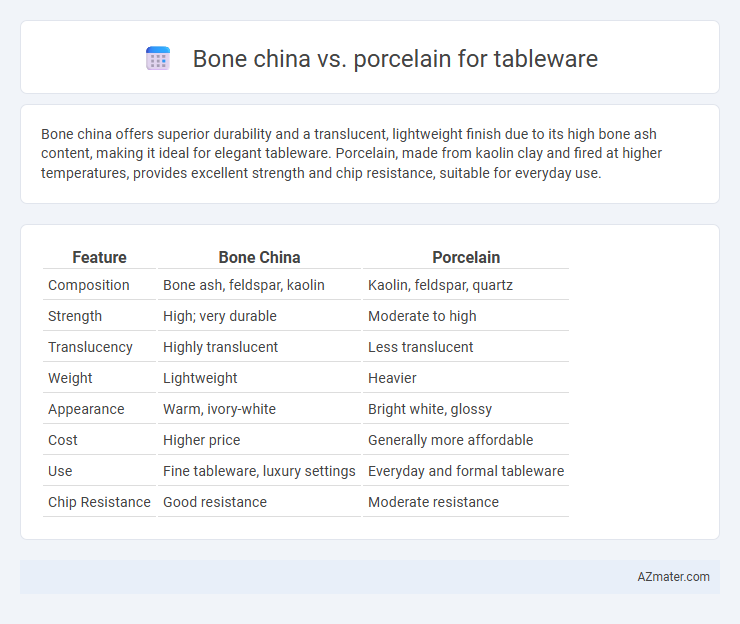Bone china offers superior durability and a translucent, lightweight finish due to its high bone ash content, making it ideal for elegant tableware. Porcelain, made from kaolin clay and fired at higher temperatures, provides excellent strength and chip resistance, suitable for everyday use.
Table of Comparison
| Feature | Bone China | Porcelain |
|---|---|---|
| Composition | Bone ash, feldspar, kaolin | Kaolin, feldspar, quartz |
| Strength | High; very durable | Moderate to high |
| Translucency | Highly translucent | Less translucent |
| Weight | Lightweight | Heavier |
| Appearance | Warm, ivory-white | Bright white, glossy |
| Cost | Higher price | Generally more affordable |
| Use | Fine tableware, luxury settings | Everyday and formal tableware |
| Chip Resistance | Good resistance | Moderate resistance |
Introduction to Bone China and Porcelain
Bone china is a type of porcelain that contains bone ash, feldspathic material, and kaolin, making it highly translucent and durable with a distinct white and smooth finish. Porcelain, often called "china," is a ceramic material made from kaolin clay fired at high temperatures, known for its strength, non-porosity, and glossy surface. Both materials are favored in tableware for their elegance and resilience, but bone china typically offers greater chip resistance and a more refined translucency compared to traditional porcelain.
Material Composition Differences
Bone china contains at least 25% bone ash, combined with kaolin and feldspar, resulting in a translucent, lightweight, yet durable tableware option. Porcelain is primarily composed of kaolin, feldspar, and quartz, which creates a denser, more opaque, and often heavier material. The inclusion of bone ash in bone china contributes to its distinct whiteness, chip resistance, and delicate appearance compared to traditional porcelain.
Manufacturing Processes Compared
Bone china is manufactured using bone ash, kaolin, and feldspar, which results in its trademark translucency and strength, while porcelain primarily consists of kaolin, feldspar, and quartz, creating a denser and more opaque material. The high firing temperatures for porcelain, typically around 1,200-1,400degC, vitrify the body, making it non-porous and rigid, whereas bone china is fired at a slightly lower temperature with a two-stage process to enhance its whiteness and durability. These distinct manufacturing processes impact the final tableware's weight, translucency, and chip resistance, with bone china being lighter and more delicate and porcelain offering increased hardness and resistance to thermal shock.
Durability and Strength Assessment
Bone china offers superior durability and strength compared to traditional porcelain due to its higher concentration of bone ash, which increases its toughness without compromising translucency. Porcelain, while also strong and chip-resistant, is generally less flexible and more prone to cracking under impact than bone china. This makes bone china the preferred choice for tableware requiring enhanced resilience and longevity in everyday use.
Appearance: Opacity, Whiteness, and Translucency
Bone china exhibits superior translucency and a creamy white appearance due to its high bone ash content, making it more delicate and light-transmitting compared to traditional porcelain. Porcelain typically presents higher opacity with a brighter, pure white finish resulting from its kaolin clay composition, but it lacks the subtle translucency characteristic of bone china. The visual distinction between bone china's warm whiteness and translucent glow versus porcelain's stark opacity is a key factor in tableware selection for elegance and aesthetic appeal.
Weight and Handling Experience
Bone china is lighter and more delicate compared to traditional porcelain, making it easier to handle and less tiring during extended use. Porcelain tends to be denser and heavier, which provides a sturdier feel but can be cumbersome for some users. The lightweight nature of bone china enhances the overall dining experience by offering a refined balance of strength and elegance.
Suitability for Everyday Use
Bone china offers exceptional durability and chip resistance, making it highly suitable for everyday use, especially in busy households. Porcelain, while also strong and heat-resistant, tends to be heavier and more prone to chipping under frequent handling. Both materials maintain elegance and practicality, but bone china's lighter weight and higher strength make it preferred for daily tableware.
Price and Value Considerations
Bone china generally commands a higher price than porcelain due to its refined composition with bone ash, which provides enhanced durability, translucency, and a lightweight feel, increasing its perceived value for tableware. Porcelain, while typically more affordable, offers excellent strength and is widely appreciated for its versatility and classic appearance, making it a cost-effective choice for everyday use. When considering price and value, bone china suits luxury settings and special occasions, whereas porcelain balances quality and affordability for regular dining.
Care and Maintenance Requirements
Bone china requires gentle cleaning with mild detergent and avoids abrasive scrubbers to maintain its delicate translucency and prevent surface wear. Porcelain is more durable but benefits from careful handling to avoid chipping and should be hand-washed or placed in a dishwasher on a gentle cycle for longevity. Both materials should be stored with padding to prevent damage and withstand regular use when properly maintained.
Which Is Best for Your Tableware Needs?
Bone china offers superior strength and translucency due to its high bone ash content, making it ideal for elegant and durable tableware that resists chipping. Porcelain, made from kaolin and fired at higher temperatures, provides excellent heat retention and a classic, opaque finish suitable for everyday use and formal settings. Choosing between bone china and porcelain depends on your preference for lightweight sophistication versus robust functionality in your tableware.

Infographic: Bone china vs Porcelain for Tableware
 azmater.com
azmater.com